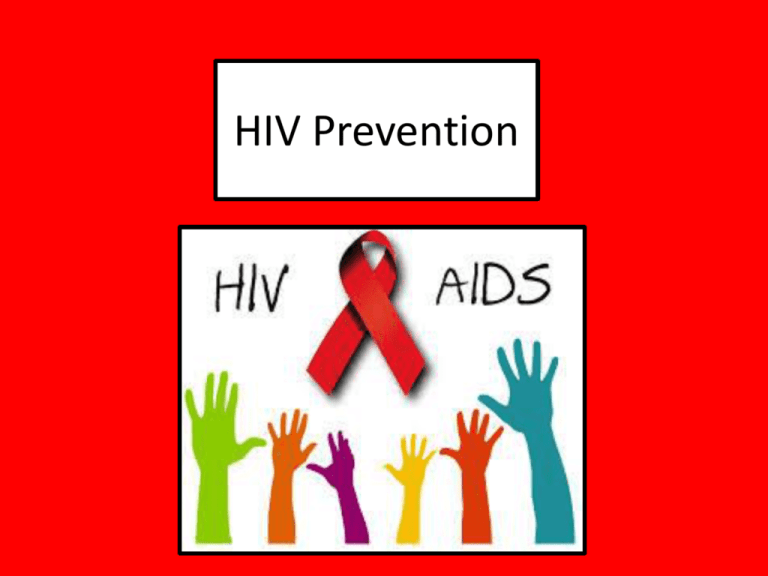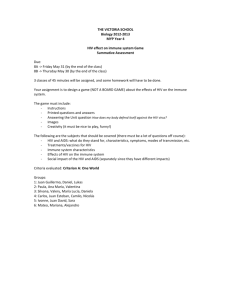
HIV Prevention
Historical Perspective
• Probably originated
in west Africa
• Virus thought to have
jumped species (from
chimpanzees to
hunters)
• Identified as GRID in
U.S. 1981
Data
• About 50,000
Americans are
infected yearly
• About 1.1 million
Americans are living
with HIV (16% do not
know their status)
• More than 635,000
have died in U.S.
• About 30 million have
died worldwide
What is HIV? What is AIDS?
• Human immunodeficiency virus
• Can lead to acquired immunodeficiency
syndrome (AIDS)
• Attacks body’s immune system, allowing
opportunistic infections
• Untreated, AIDS is
almost universally fatal
How HIV is Spread
Through blood or
body fluid contact with
infected person
– Unprotected sexual intercourse
(oral, anal, and penis-vagina)
– Sharing needles
– From mother to child
• While baby develops in mother’s
uterus
• At time of birth
• During breastfeeding
How HIV is NOT Spread
•
•
•
•
•
•
•
•
Hugs or handshakes
Drinking glasses
Sneezes, coughs
Kissing
Mosquitos
Towels
Toilet seats
Doorknobs
Signs and Symptoms of HIV:
Teens and Adults
• Often show no
symptoms at time of
infection
• Can pass virus to
others before status is
known
• May take up to 10
years for symptoms to
show
Stages of HIV
• Acute infection
– 2 – 4 weeks after infection
– May feel sick with flu-like symptoms
• Clinical latency (often called asymptomatic)
– Those on ART, this stage may last decades
– Those not on ART, this stage may last up to a decade
• AIDS
– Immune system badly damaged
– Vulnerable to opportunistic infections
Symptoms of AIDS:
Teens and Adults
•
•
•
•
•
•
Rapid weight loss
Intense fatigue
Swollen lymph nodes
Persistent diarrhea
Night sweats
Pneumonia
Opportunistic Infections
Definition: HIV weakens
one’s immune system,
increasing susceptibility to:
• Tuberculosis
• Viral and bacterial
infections
• Cancers
– Kaposi’s sarcoma
– Lymphomas
•
•
•
•
Pneumonia
Wasting syndrome
Kidney disease
Dementia
Prevention of HIV
• Delay intimate sexual
behavior
• Limit sexual partners
• Get tested and share results
with potential partner
• Use latex condoms and
dental dams with all
intimate sexual behaviors
• Do not share injection drug
equipment
Prevention of HIV in Babies
• Get tested if planning a pregnancy or early
in pregnancy
• If pregnant and HIV positive, ART can
reduce risks from 20% to 2%
• If HIV positive, do not breastfeed baby
Testing for HIV
• Testing only way to know
• HIV tests detect antibodies
in saliva or blood
• Go to www.hivtest.org
• Testing is easy, free, and only takes
20 minutes
• Antibodies can be detected
between 12 weeks and 6 months
after exposure
• Care should be taken to avoid
infecting others
Testing for HIV: Where to Go
• HIV testing zip code
locator website:
http://hivtest.cdc.gov
• Public Health
Department
• Health care provider
HIV Tests
• Confidential
• Blood or saliva
– Standard blood test: results in 2 weeks, sent to state lab
– Rapid test: results in 20 minutes
• Counseling and provision of resources:
– status
– treatment options
– scheduling medical appointment
– preventing infection of others
– notification of partner
HIV Testing
(may be different in
some counties)
•
•
•
•
•
•
See a nurse to assess risk factors
Receive counseling on risk reduction
Sent to lab to get test
Come back in 2 weeks for results
If negative, no contact will be made
If positive, disease intervention specialist will discuss
treatment and contact partners (name not divulged)
Barriers
to
Testing
•
•
•
•
Stigma
Fear
Lack of awareness of risk factors
Unwillingness to change behavior
If Test is Positive . . .
• Regular blood tests
• Treatment usually
starts when immune
system weakens
• NCDHHS will inform
partner(s)
• Use condoms
consistently and
correctly
Treatment
• ART is antiretroviral therapy (combination of
HIV medications)
• ART cannot cure HIV, but can help people live
longer healthier lives
• 1 or 2 pills once a day
• There are side effects
• Must be taken the rest of one’s life
Overcoming Apathy





